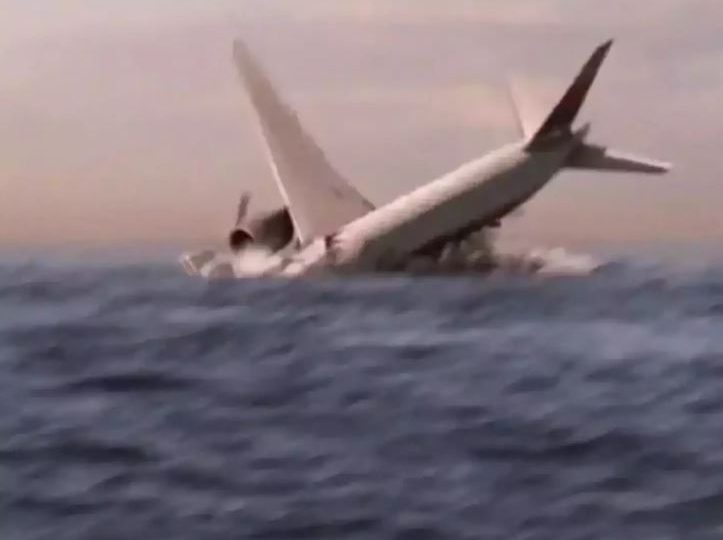A NEW hunt for the missing passenger plane MH370 is ready to launch after a “credible” search plan with new evidence was submitted to the Malaysian government.
Underwater robotics company Ocean Infinity revealed to The Sun that it had submitted its search proposal – and three of its robot vessels now ready and waiting for the green light from officials.
National GeographicA computerised reenactment shows MH370 crashing into the Southern Indian Ocean as part of a documentary[/caption]
ReutersSince 2014 only a few pieces of confirmed debris from the jet have ever been found[/caption]
Underwater robotics company Ocean Infinity has three underwater vessels ready for action
If signed off, it could begin this month and take three months to complete, according to reports.
Malaysia’s Transport Minister Anthony Loke confirmed that Government officials were in “advanced talks” with the US-based marine exploration company over a plan submitted in June this year.
The search would resume in a 15,000sqkm area off the coast of Western Australia, near the last known location of the doomed jet.
Ocean Infinity’s plan has a “no find, no fee” meaning if the search is successful a $70million bill would be paid by the Government.
Loke said: “Based on the latest information and analysis from experts and researchers, Ocean Infinity’s search proposal is credible and can be considered by the Malaysian government as the flight’s official registrar.
“The terms and costs requested are in the same draft agreement currently being negotiated between the government and Ocean Infinity.
“Should it be finalised, cabinet approval will be required, and I will make a public announcement.”
It’s thought that WSPR technology could play a big part in the search with Professer Simon Maskell acting as an adviser to the Ocean Infinity team.
Simon and his team at Liverpool Univeristy have been investigating the possibility of using WSPR technology to detect and track aircraft.
It’s also been revealed that the company may be looking at hydrophone data, sound picked up by underwater microphones, as part of their plans.
The Malaysian Airlines flight disappeared from flight radar screens on March 8th 2014 as it flew from Kuala Lumpur to Beijing with 239 people onboard.
The plane’s disappearance sparked the biggest search in aviation history and to this day the wreckage of the jet, presumed to have crashed in the Southern Indian Ocean, remains undiscovered.
Many theories have emerged in the ten years since it vanished, including the possibility of a depressurized cabin sparking a ghost flight into oblivion or a suicidal pilot carrying out a perfect ditching.
The official MH370 narrative suggests the plane made a bizarre U-turn, flying across Malaysia, turning northwest at Penang Island and across the Andaman Sea.
Data from military radar and satellite data revealed that the plane flew on for hours towards the Southern Indian Ocean where it crashed in an unknown location.
Ocean Infinity’s search proposal is credible and can be considered by the Malaysian government as the flight’s official registrar
Anthony Loke
Several searches and a series of blunders mean the missing jet has never been found but loved ones and experts pushing for a new investigation have been given a glimmer of hope.
Aviation journalist Jeff Wise told The Sun: “
There’s a general sense among the public that, having searched the seabed and failed to find the plane, the authorities should just keep searching further.
“But where? The seabed search was based on the analysis of signals sent by the plane to an Inmarsat satellite.
“This analysis was used to generate a probability heat map, with a high probability in the middle, and progressively lower probability as you move outward.
“The further out you go, the less and less likely you are to find that plane in any particular square mile.”
“It implies that someone has come up with either new information or a new analysis to focus on a particular area.
“If they do launch the search, and it fails again, it will be high time for search officials to start grappling with this history of failure by asking hard questions about the assumptions they’ve made — most particularly, why they were so quick to assume that it couldn’t possibly have been a cyberattack when multiple cybersecurity experts say it very well might have been.”
Previously Malaysian Prime Minister Anwar Ibrahim said his country would be willing to reopen the investigation into the disappearance of the flight if there was compelling new evidence.
Underwater robotics company Ocean Infinity confirmed to The Sun that a search proposal had been submitted to the Malaysian government and it’s believed a new hunt could begin before the end of the year.
Ocean Infinity CEO Oliver Plunkett said: “We now feel in a position to be able to return to the search for missing aircraft MH370, and have submitted a proposal to the Malaysian government.
“Finding MH370 and bringing some resolution for all connected with the loss of the aircraft has been a constant in our minds since we left the southern Indian Ocean in 2018.
“Since then, we have focused on driving the transformation of operations at sea; innovating with technology and robotics to further advance our ocean search capabilities.
“This search is arguably the most challenging, and indeed pertinent one out there. We’ve been working with many experts, some outside of Ocean Infinity, to continue analysing the data in the hope of narrowing the search area down to one in which success becomes potentially achievable.
“We hope to get back to the search soon.”
We now feel in a position to be able to return to the search for missing aircraft MH370
Oliver Plunkett
The company first searched for the doomed jet in January 2018 with its Seabed Constructor robot but was unsuccessful.
The underwater machine went on to discover the wreck of the Argentine San Juan submarine after it vanished in 2017 killing all onboard.
Ocean Infinity has been involved in several high-profile projects such as the search for Ernest Shackleton’s ship and the hunt for the Stellar Daisy the largest ship ever to be lost at sea.
In May this year, Malaysian Transport Minister Anthony Loke announced that a discussion with Ocean Infinity had taken place where evidence had been submitted.
He said that the proposal would need to be examined by the cabinet before a final decision could be made.
Getty – PoolSeveral searches including the biggest hunt in aviation history have failed to find the wreckage of MH370[/caption]
APFlight officer Rayan Gharazeddine scans the southern Indian Ocean during a search on March 22, 2014[/caption]
EPAFamily members of missing passengers and crew at a remembrance event marking the 10th anniversary of the disappearance[/caption]
In the meantime, Ocean Infinity is poised for action with a number of underwater robots lined up for the search.
Three high-tech vessels are waiting near Malaysia – the Armada 78 04 and the 06 are all moored in the port of Singapore while the 78 08 is stationed in the South China Sea.
It’s believed that the 06 robot is already making practice runs in the area in waters up to 6,500ft deep.
MYSTERY SIGNAL
The Sun spoke to Dr Usama Kadri, a professor of maths and engineering at Cardiff University, who believes that underwater microphones, known as hydrophones, could be key to finding the doomed jet’s final resting place.
As part of a study that analysed hundreds of hours of hydrophone data from previous plane crashes into the world’s oceans – he believes one eerie split-second noise could be the last ever trace of MH370.
Usama explains that the only way to know for sure would be to conduct an experiment imitating the impact of the crash on the ocean’s surface as suggested by the official narrative.
Talking to The Sun exclusively, he says the outcome of this experiment would finally take us “one step closer to the truth”.
Speaking about the chilling boom, Dr Kadri said: “If you want to listen to it[MH370 sound] it has to be in the audible range.
“These signals normally are somewhere between 2 hertz and 40 hertz, but if it’s below 20 hertz you can’t hear anything.
He explains that he can make the sound 40 times faster so that it’s audible – but that it would make the noise just a fraction of a second long.
He adds: “The problem with these signals [MH370sound] is that they are already short.”
He describes the sound as more of a chilling feeling that travels through your body – he says to imagine a very deep organ sound but with an even lower frequency.
Hydrophones can detect ocean sounds from all directions with 11 stations set up around the world to monitor submarines, marine animals and underwater earthquake and volcano activity.
Having previously worked on underwater sound waves, Usama took an interest in the search for MH370 and reached out to the official search team based in Australia in 2014.
Usama and his team set about analysing hundreds of hours worth of hydrophone data from the Comprehensive Nuclear-Test-Ban Treaty Organization’s (CTBTO) hydroacoustic stations.
There appeared to be one unidentified event in an area known as the Seventh Arc that was picked up at the Leeuiwn station.
Why is MH370 still missing a decade on?
By Rebecca Husselbee, Assistant Foreign Editor
When an entire plane with 239 passengers mysteriously disappeared from the sky it left the world in utter disbelief – myself included.
How could an entire jet vanish into oblivion in a modern world when every move on land, sea and air is tracked? And how could it remain lost for a decade?
Having spent the last few years exploring the many theories on what MH370’s final moments might look like, from the bizarre to the complex, there is one hypothesis that answers every question for me.
Pilot Simon Hardy has left no stone unturned in his search for answers and having been at the helm of passenger flights for over 20 years he knows every inch of a Boeing 777 cockpit.
What makes his “technique, not a theory” even more compelling is his ability to access the world’s best flight simulators and sit in Captain Zaharie Ahmad Shah’s seat as he commandeered the Malaysia Airlines and flew into the middle of the Southern Indian Ocean.
While others believe WSPR technology holds the key to finally discovering the wreckage, it’s never been proven and many in the MH370 community have questioned its reliability.
Many experts agree that the “suicidal” MH370 pilot was behind the plane’s demise – what we’ll never know is what his mindset was on that night and what motive he had to carry out such a chilling plan.
Passenger safety onboard in the aviation industry is rigorous and the likelihood of travellers being involved in a plane crash is 1 in 11 million.
But are airlines considering a pilot’s mental state when they sit at the controls of a jet that could be turned into a 300-ton death machine?
The Seventh Arc is an area of the ocean where the last known satellite communication with MH370 occurred.
Talking about the study previously, Dr Kadri said: “A 200-tonne aircraft crashing at a speed of 200 metres per second would release the kinetic energy equivalent to a small earthquake.
“It would be large enough to be recorded by hydrophones thousands of kilometres away.”
But Dr Kadri explains that his initial analysis focused on a very narrow window of around ten minutes – a timeframe determined by the official narrative.
However, the signal picked up near the Seventh Arc at the Leeuiwn station didn’t exactly fit with the crash timeline and was just slightly outside the timeframe.
Dr Kadri believes the search would therefore have to be revisited to determine whether the chilling signal is really the last known trace of MH370.
Speaking to The Sun he said: “When we initially looked at the signals, we were looking in the direction of the Seventh Arc.
“According to the investigation we had to look within two hours and within these two hours…we had to look within a window of ten minutes.
“For me, that is a little bit too accurate because of all the uncertainty but that was the requirement.
“Within these ten minutes, we could not find anything from the Seventh Arc or the last communication [with the plane].
“If you allow a little bit longer, only tens of minutes more, there was a signal which came from the direction of the Seventh Arc and that signal was also highlighted by another[research] group.
“That was the only, the strongest signal actually, that was picked up from that direction.”
Refer to CaptionCaptain Zaharie Ahmad Shah was at the helm when the plane vanished from radar screens[/caption]
EPAThe plane vanished with all 239 passengers onboard with only a few pieces of washed-up debris ever found[/caption]
ReutersFamilies of passengers have been left desperate for answers after nearly a decade with no closure[/caption]
Leave a comment








